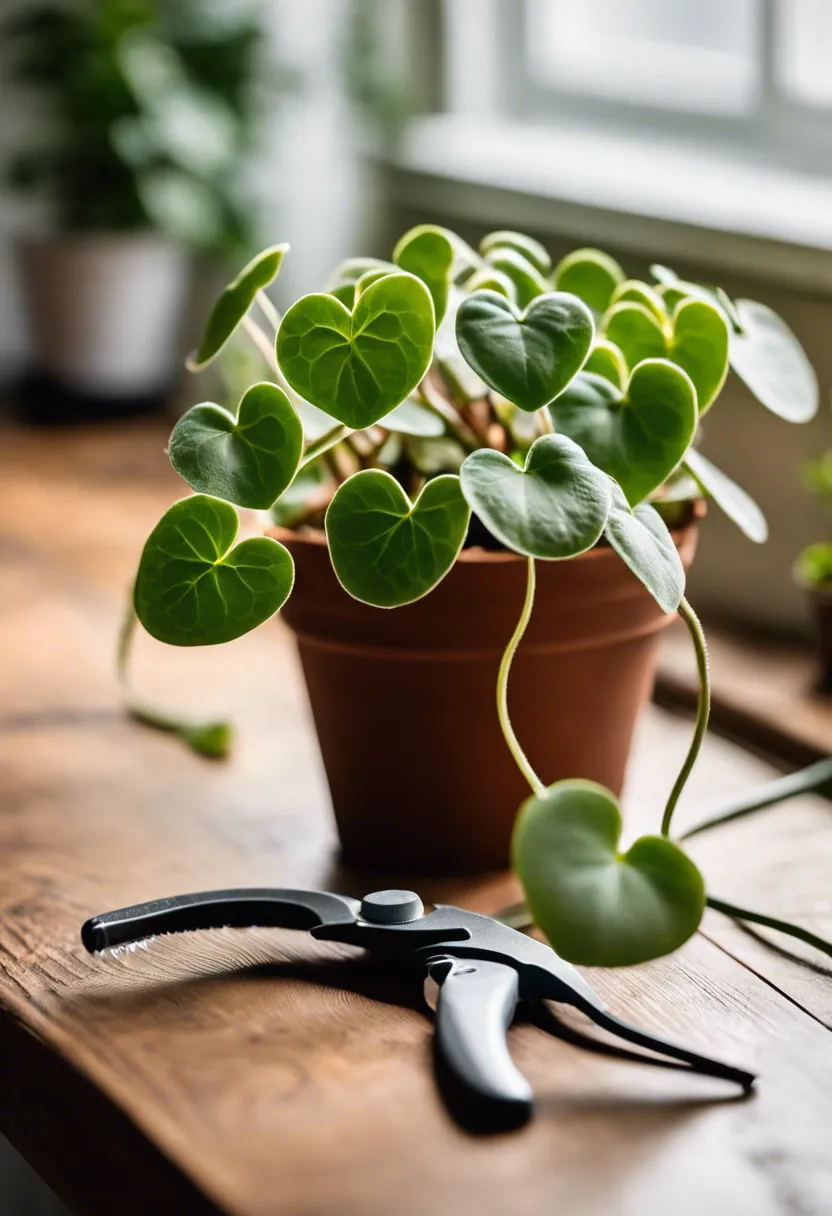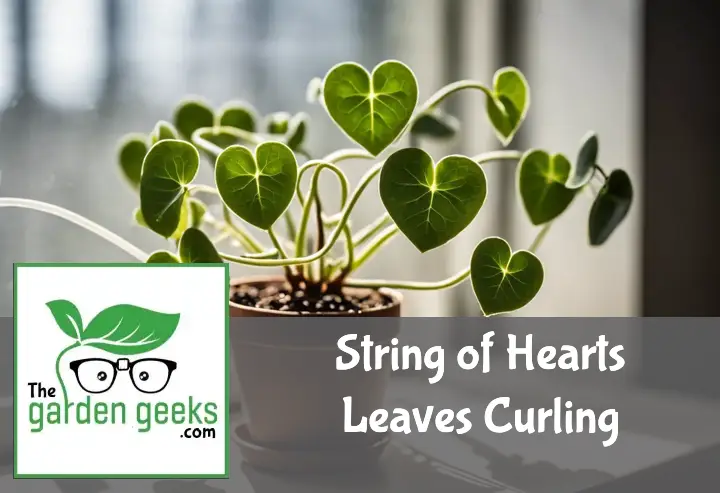Hey there, plant lover! Noticed your String of Hearts Leaves Curling lately? Don’t fret! That’s a common issue, and we’re here to help you solve it.
In this blog post, we’ll delve into the causes behind this problem and provide practical solutions to get your plant back in shape. So sit tight, grab a cup of coffee, and keep reading about String of Hearts Leaves Curling? (How to Solve it).
Remember, every plant has its quirks. Understanding them is the key to successful gardening. Let’s unravel the mystery together!
Key Takeaways
- String of Hearts leaves curling is often due to improper watering, either too much or too little.
- Overwatering can lead to root rot, causing the leaves to curl and yellow. Underwatering can cause dehydration and curling.
- The plant prefers bright indirect light. Too much direct sunlight can burn the leaves, causing them to curl.
- It’s also sensitive to temperature changes. Keep it in a stable environment away from drafts or sudden temperature swings.
- Regularly check for pests like aphids and spider mites that may cause leaf curling.

Understanding the String of Hearts Plant
Dive into the world of String of Hearts care and discover everything about this enchanting indoor trailing plant. From its origins to the unique vine plant care it requires, get ready to become a pro at nurturing these heart-shaped beauties.
The Origin and Characteristics of String of Hearts
The String of Hearts, scientifically known as Ceropegia woodii, is a captivating vine that hails from the rugged terrains of South Africa. With its delicate, trailing vines adorned with petite, heart-shaped leaves, it’s no wonder this plant has captured the hearts of indoor gardeners worldwide. Not just a pretty face, its resilience and easy-going nature make it a popular choice for those looking to add a touch of whimsy to their indoor spaces. As an indoor decorative plant, it thrives in bright, indirect light, showcasing its beauty without demanding constant attention. Its aesthetic appeal lies not only in its foliage but also in its ability to effortlessly cascade over the edges of pots or shelves, creating a stunning visual display that enchants all who gaze upon it.
Ideal Growing Conditions for String of Hearts
Creating the perfect environment for your String of Hearts is key to seeing those charming vines flourish. First off, let’s talk light – these plants are sun worshippers at heart but prefer not to be scorched. Bright, indirect sunlight will keep them happy and healthy without causing any leaf burn. When it comes to temperature, think warm thoughts; they enjoy conditions similar to their native African climate. However, they’re adaptable and can tolerate cooler temperatures as long as you keep them away from drafts.
Soil-wise, well-draining is the way to go. A mix that allows for good air circulation around the roots will prevent waterlogging and promote healthy growth. And speaking of water – less is more here. Overwatering is a common misstep; letting the soil dry out between watering mimics the dry periods they experience in their natural habitat.
Common Problems Encountered by String of Hearts Plants
Even with impeccable care, your String of Hearts might run into some trouble now and then. Pests like aphids or spider mites can take a liking to your plant but fear not – regular inspection and prompt action can keep these unwelcome guests at bay.
Diseases aren’t common but can occur if conditions aren’t ideal; overwatering can lead to root rot while too little light may weaken your plant making it more susceptible.
Environmental stressors such as sudden temperature changes or inadequate lighting can also affect your plant’s health leading to symptoms like yellowing leaves or stunted growth.
But don’t despair! Most issues are manageable with early detection and proper care adjustments ensuring your vine remains vibrant and thriving.
Why are Your String of Hearts Leaves Curling?
If you’ve noticed your String of Hearts leaves curling, it’s time to play plant detective. Let’s dive into the usual suspects: watering mishaps, temperature tantrums, and light laments.
Lack of Water and Its Effects on Leaf Curling
When your String of Hearts starts looking more like a string of tiny green tacos, underwatering might be the culprit. This plant loves a good drink, but only when its soil has dried out a bit. Underwatering symptoms include dry, crispy leaves that curl up in despair. It’s like they’re trying to conserve every last drop of moisture they can get their parched little leaf hands on.
But fear not! Establishing a String of Hearts watering guide is easier than you think. Start by sticking your finger into the soil; if it feels dry an inch below the surface, it’s time for water. Consider using a pot with drainage holes to avoid any soggy soil situations. By giving your plant a consistent drink based on its needs rather than a strict schedule, you’ll prevent those pesky leaf curls and keep dehydration at bay.
Overwatering and Its Impact on Leaf Curling
On the flip side, giving your String of Hearts too much love in the form of water can also lead to trouble. Overwatered plants often have swollen, mushy leaves that curl as an SOS signal. This excessive enthusiasm for watering can lead to root rot – every plant parent’s nightmare.
The key here is balance and proper soil drainage for houseplants. Opt for well-draining soil and pots with drainage holes to let excess water escape freely. This setup helps mimic the natural drying process, keeping roots happy and preventing overwatered-induced leaf curling.
Temperature Fluctuations Leading to Leaf Curling
Think of your String of Hearts as Goldilocks – it doesn’t like it too hot or too cold; it wants the temperature just right. Sudden changes or extremes can cause leaf curl as the plant tries to protect itself from temperature stress.
To keep things cozy, aim for an ideal temperature for String of Hearts, which is between 60-80°F (15-26°C). Keep them away from drafty windows or blasting heaters that could cause dramatic temperature shifts. A stable environment will help prevent those curls from forming in response to temperature swings.
Inadequate Light as a Cause for Leaf Curling
Last but not least, let’s talk about light – or lack thereof. Without enough rays, your String of Hearts might start curling its leaves towards any light source it can find in a desperate search for energy.
This doesn’t mean you should stick them under direct sunlight all day long; these plants prefer bright indirect light. If you notice signs of inadequate lighting such as leggy growth or fading color along with leaf curling, consider moving your plant closer to a window or supplement with artificial lights designed for plants. Finding that sweet spot will help straighten out those curls and ensure your String of Hearts thrives.



Step-by-Step: Solving the Problem of Curling Leaves in String of Hearts


So, your String of Hearts is throwing a bit of a tantrum with its leaves curling up tighter than a roll of dollar bills in a hipster’s jean pocket. No worries! We’re about to embark on a rescue mission that’ll have those leaves flattening out and behaving in no time. Let’s dive into the step-by-step guide to uncurl those leafy frowns.
-
Check the watering schedule: First things first, let’s talk water. These plants are like that friend who never knows if they’re thirsty or not. Too much water? Leaves curl. Too little? Same deal. Aim for the Goldilocks zone – just right. Stick your finger into the soil; if it feels dry a couple of inches down, it’s time to water. If it’s damp, hold off on the H2O for a bit longer.
-
Evaluate light conditions: Next up, lighting! String of Hearts loves bright, indirect sunlight but turns into a drama queen with too much direct sun or too little light, leading to leaf curling as an SOS signal. Find a spot where it can bask in bright but indirect light for most of the day – think near a window with sheer curtains for that perfect selfie lighting.
-
Assess humidity levels: These plants don’t need tropical jungle humidity but think more along the lines of a comfortable spring morning. Too dry and their leaves start rolling up tighter than cinnamon rolls. Consider placing a humidifier nearby or grouping it with other plants to create its own little microclimate party.
-
Inspect for pests: Uninvited guests can also cause leaf curling drama. Check under the leaves and along stems for signs of pests like aphids or spider mites – tiny critters that throw massive parties at the expense of your plant’s health. If you spot any, gently wipe them away with soapy water or an appropriate insecticide.
-
Review fertilization practices: Overfeeding or underfeeding can lead to nutrient imbalances and yes, you guessed it, curling leaves! During growing seasons (spring and summer), feed your String of Hearts with a balanced liquid fertilizer once every month but give it some rest during fall and winter – no snacks needed!
-
Ensure proper potting mix and drainage: Last but not least, these heart-string players love well-draining soil that doesn’t hold onto water like clingy exes do to memories. Make sure they’re potted in a mix designed for succulents or cacti and that their pots have drainage holes quicker than escape routes at awkward family gatherings.
By following these steps closely, you should see improvements in your String of Hearts’ demeanor in no time! Remember, patience is key; give your plant some time to adjust and respond to these changes before expecting significant improvements.
Preventive Measures to Avoid Future Leaf Curling
So, you’ve nursed your String of Hearts back from the brink of a curl-up catastrophe and now you’re wondering how to keep those lovely leaves flat and fabulous? Fear not! Here’s a handy list of do’s that’ll keep your plant looking more like a lush vine and less like a bowl of potato chips.
-
Check the lighting: Too much sun can fry your plant’s leaves, while too little will have it reaching for the stars (or the nearest light source). Find that Goldilocks zone where your String of Hearts gets bright, indirect light.
-
Monitor watering habits: Over-watering is a no-no. Wait until the top inch of soil is dry before giving it a drink. Under-watering isn’t great either; if the soil looks like it’s about to start cracking, it’s time to water.
-
Maintain humidity levels: These plants don’t need a rainforest environment but appreciate a bit of moisture in the air. If your home is drier than a desert, consider using a humidifier or placing a water tray near your plant.
-
Choose the right soil: A well-draining potting mix is key. Think of it as making a comfy bed for your plant’s roots – you wouldn’t want to sleep in a swamp, and neither do they.
-
Fertilize with care: Feed your String of Hearts with a balanced liquid fertilizer during its growing season (spring and summer), but don’t overdo it. It’s better to under-feed than over-feed.
Remember, prevention is better than cure. By keeping an eye on these factors, you’ll ensure your String of Hearts remains healthy, vibrant, and most importantly, uncurled!


To Wrap Up
In conclusion, your String of Hearts Leaves Curling is not a death sentence for your beloved plant. It’s simply communicating its needs to you – too much or too little water, inadequate light, or temperature fluctuations could be the culprits.
Remember that each plant has its own personality and will respond differently to changes in care. So don’t panic! Instead, experiment with different conditions until your String of Hearts shows signs of happiness again.
Finally, share your journey and learn from others on this Reddit thread. Together we can make our indoor jungles thrive!


